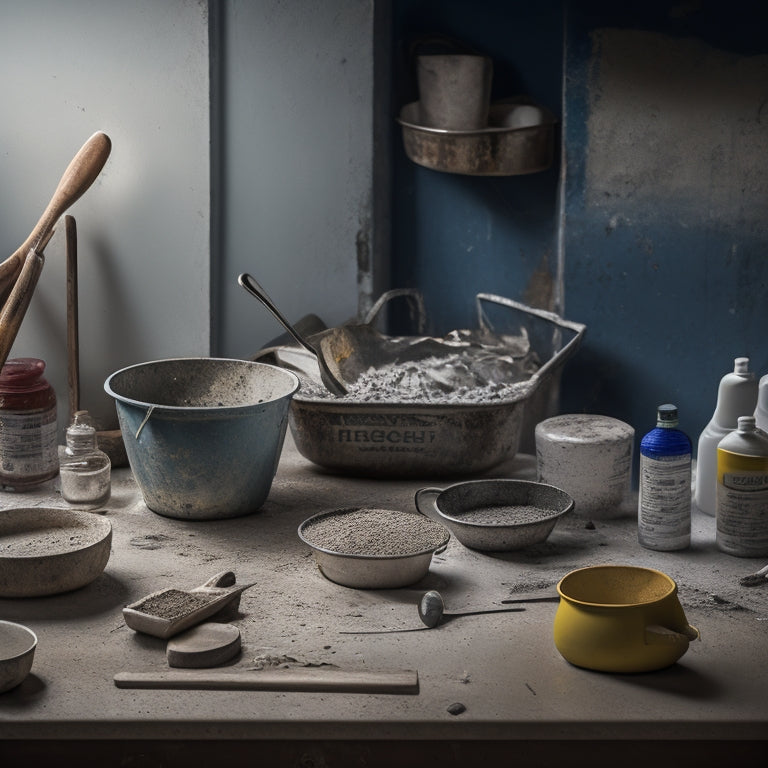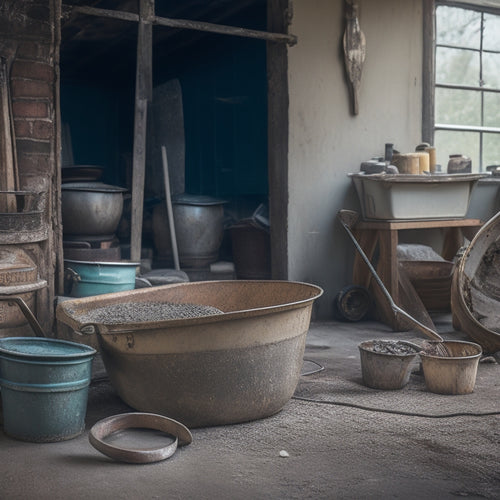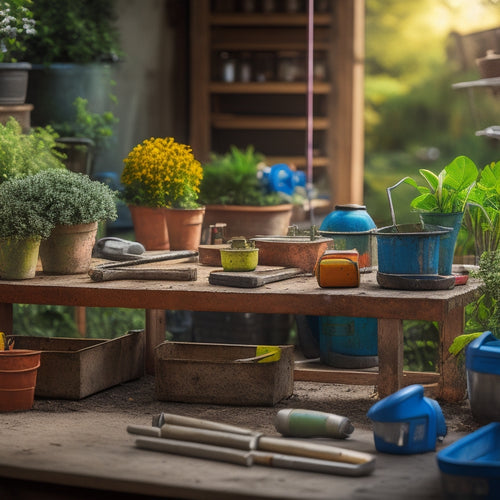
Top 5 Tools for Hand-Mixing Perfect Concrete
Share
When hand-mixing perfect concrete, you'll need a sturdy mixing bucket, ideally steel or plastic, that's large enough for the entire batch. Accurate measuring cups and a pouring spout guarantee correct proportions and smooth pouring. A cordless drill with a mixing paddle or a dedicated concrete mixer will help you achieve a uniform mix. Don't forget tamping and smoothing tools, like a tamping rod and float, to compact and finish the surface. Finally, a finishing trowel and edging tool will give your concrete a polished, professional look - and that's just the beginning of your path to concrete perfection.
Key Takeaways
• Use a sturdy steel or plastic bucket that's large enough to hold the entire concrete batch for efficient mixing.
• Invest in a reliable mixing equipment, such as a cordless drill with a mixing paddle, for thorough blending.
• Employ a tamping tool, like a sturdy tamping rod or hand tamper, to ensure effective compaction and even surfaces.
• Utilize a measuring cup with clear markings to accurately measure ingredients and maintain the optimal mixing ratio.
• Implement a pouring spout to facilitate smooth, even pouring and minimize spills for a professional finish.
Mixing Bucket Essentials
Your mixing bucket is the foundation of a successful concrete mixing operation, so it's vital to have the right equipment and accessories on hand. You'll want to choose a bucket that's sturdy, easy to clean, and resistant to corrosion.
There are two primary types of buckets to take into account: steel and plastic. Steel buckets are durable and ideal for heavy-duty mixing, while plastic buckets are lighter and more affordable. Regardless of which type you choose, make sure it's large enough to hold the entire batch of concrete.
When it comes to mixing ratios, it's important to get it right. A general rule of thumb is to use one part cement, two parts sand, and three parts aggregate. However, this ratio may vary depending on the specific project requirements and the type of concrete you're using.
Always follow the manufacturer's instructions and take necessary safety precautions when mixing concrete. Remember to wear protective gear, including gloves, safety glasses, and a dust mask, to prevent injury and exposure to hazardous materials.
With the right bucket and mixing ratio, you'll be well on your way to mixing perfect concrete.
Tamping and Smoothing Tools
Five essential tamping and smoothing tools will help you achieve a professional finish, ensuring your concrete surfaces are even, compact, and visually appealing.
When it comes to tamping, you'll need a tool that can effectively compact the concrete, removing any air pockets or excess water. A sturdy tamping rod or hand tamper is perfect for this task, allowing you to apply consistent pressure without straining your back.
For smoothing methods, a float or trowel is a must-have. These tools help to level and smooth out the surface, removing any imperfections or bumps. Use a float to achieve a rough finish, and then switch to a trowel for a finer, more polished finish.
Don't forget to use an edger or jointer to create clean, defined edges and joints. Finally, a finishing trowel or darby will help you achieve a high-gloss finish.
Measuring and Pouring Aids
With your concrete surface prepared and smoothed, it's time to focus on measuring and pouring the perfect mix, and that's where accurate measuring and pouring aids come in.
You can't afford to get it wrong at this stage, as inaccurate measurements can lead to a subpar concrete mix that compromises the entire project. That's why you need reliable measuring cups to guarantee you're using the right proportions of cement, sand, and water. Look for cups that are specifically designed for concrete mixing, with clear markings and a sturdy build to withstand the rigors of the job.
When it comes to pouring the mix, a pouring spout can be a game-changer. These handy tools allow you to pour the concrete smoothly and evenly, reducing the risk of spills and messes. They also help you maintain control over the flow of the mix, guaranteeing that it reaches all areas of the pour without pooling or running off.
Mixing and Blending Equipment
Now that you've accurately measured and poured your concrete mix, it's time to tackle the crucial step of mixing and blending, where a powerful drill and mixing paddle or a dedicated concrete mixer take center stage.
You'll need to choose the right mixing equipment to guarantee a smooth, consistent finish. A cordless drill with a mixing paddle attachment is a popular choice, offering the power and control you need to mix small to medium-sized batches. Alternatively, a dedicated concrete mixer provides a more efficient and ergonomic solution for larger batches.
When it comes to mixing techniques, it's vital to follow the manufacturer's instructions for the correct blending ratios. Typically, you'll want to mix the concrete in a circular motion, starting from the center and working your way outwards.
Be sure to scrape the sides and bottom of the mixing bucket to verify all materials are fully incorporated. By using the right mixing equipment and following proper mixing techniques, you'll achieve a uniform, lump-free mix that's ready for finishing.
Finishing and Texturing Tools
As you move on to the finishing stage, you'll need a range of specialized tools to achieve the desired texture and appearance for your concrete surface. This is where the magic happens, and your concrete begins to take shape.
For a smooth finish, you'll need a variety of trowels, each designed for specific trowel techniques. A steel trowel is ideal for applying surface treatments, such as sealing or staining, while a rubber trowel is better suited for creating a textured finish.
A finishing float is another vital tool for achieving a smooth, even surface. It helps to remove excess water and air pockets, leaving your concrete looking professional and polished.
An edging tool is also important for creating clean, crisp edges and joints. Finally, a broom or brush is necessary for adding texture and pattern to your concrete surface.
Frequently Asked Questions
Can I Mix Concrete in a Wheelbarrow Instead of a Bucket?
You're wondering if you can mix concrete in a wheelbarrow instead of a bucket. The answer is yes, but consider the wheelbarrow's capacity first.
A larger mixing area means you can handle bigger batches, but it also demands more mixing effort.
Mastering your mixing techniques is essential to avoid uneven consistency.
Make certain to scrape the sides and bottom of the wheelbarrow thoroughly to guarantee a smooth, safe mix.
How Do I Prevent Concrete From Sticking to My Tools?
You're about to plunge into the messy world of concrete mixing, but first, let's talk about the pesky problem of concrete sticking to your tools.
You don't want to be stuck scrapping away at dried concrete, trust us. To prevent this, make sure you're using a concrete release agent on your tools before mixing.
Regular tool maintenance is also key - clean and oil your tools after each use to keep them in top shape.
With these tips, you'll be mixing like a pro in no time!
Can I Use a Drill With a Mixing Paddle for Small Batches?
You're wondering if you can use a drill with a mixing paddle for small batches. The answer is yes, but be cautious.
Choose a drill with a low-to-medium torque setting to avoid splashing concrete.
Opt for a mixing paddle designed for concrete, with sturdy blades and a comfortable grip.
Use a controlled, gentle mixing technique to avoid air pockets and achieve a smooth consistency.
What's the Ideal Temperature for Mixing and Pouring Concrete?
When mixing and pouring concrete, you'll want to keep an eye on the temperature. Extreme temperatures can affect the final product's strength and durability.
Ideal temperatures range from 50°F to 90°F (10°C to 32°C). Avoid mixing in direct sunlight or during extreme weather conditions.
Proper mixing techniques, like gradual water addition and thorough mixing, also play an essential role in achieving perfect concrete.
Can I Mix and Pour Concrete in the Rain or High Winds?
Can you really afford to take the risk?
Mixing and pouring concrete in the rain or high winds is a recipe for disaster.
Rain effects can cause the concrete to become weak and prone to erosion, while wind considerations can make it difficult to control the pour.
Don't gamble with safety - wait for a calm, dry day to guarantee a strong and durable finish.
Conclusion
You've got the lowdown on the top 5 tools for hand-mixing perfect concrete. Now, it's time to get mixing!
Imagine yourself as a master builder from ancient Rome, constructing a majestic aqueduct that'll stand the test of time.
With these essential tools, you'll be well on your way to creating concrete masterpieces that'll make the Colosseum proud.
So, grab your mixing bucket, tamping tool, and get ready to build something that'll last for centuries!
Related Posts
-

Top Tools for Mixing Concrete at Home
When mixing concrete at home, you'll need a range of tools to guarantee a successful operation. Start with essential ...
-

Why These Tools Are Crucial for Concrete Patio
You're about to commence on a concrete patio project, and having the right tools is vital to achieving professional-l...
-

Must-Have Tools for Concrete Planter Projects
As you commence your concrete planter project, you'll need a range of specialized tools to achieve professional-grade...


